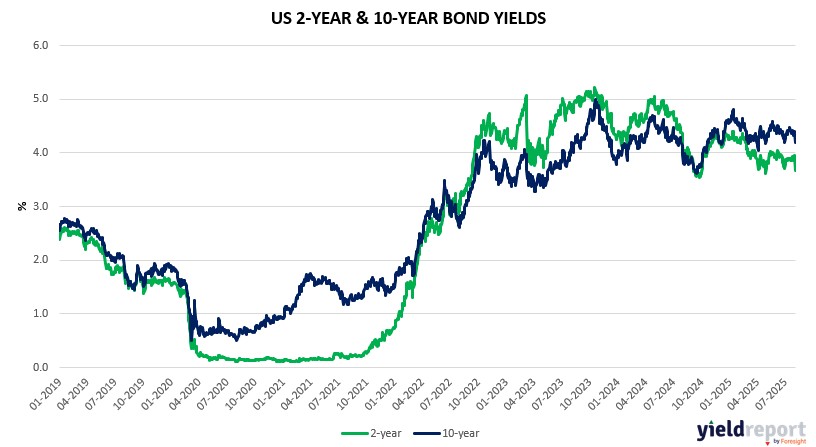| Close | Previous Close | Change | |
|---|---|---|---|
| Australian 3-year bond (%) | 3.337 | 3.33 | 0.007 |
| Australian 10-year bond (%) | 4.228 | 4.268 | -0.04 |
| Australian 30-year bond (%) | 4.963 | 5.027 | -0.064 |
| United States 2-year bond (%) | 3.706 | 3.681 | 0.025 |
| United States 10-year bond (%) | 4.216 | 4.198 | 0.018 |
| United States 30-year bond (%) | 4.8081 | 4.795 | 0.0131 |
Overview of the Australian Bond Market
Australian government bond yields edged lower on August 5, 2025, reflecting cautious optimism amid global economic signals. The 2-year yield fell 8 basis points to 3.31%, the 5-year yield dropped 10 basis points to 3.61%, and the 10-year yield declined 9 basis points to 4.22%. The 15-year yield saw an 8 basis point decrease to 4.58%. These movements align with expectations of softer monetary policy in both Australia and the US, driven by recent economic data.
The S&P Global Services PMI Final for July 2025 came in at 54.1, and the Composite PMI at 53.8, indicating continued expansion in Australia’s services and broader economy. However, global growth concerns, including a disappointing US ISM Non-Manufacturing PMI of 50.1 (below the expected 51.5), tempered enthusiasm. Investors are closely watching upcoming Australian trade data, with the Balance on Goods for June 2025 expected to show a surplus of AUD 2,500 million, alongside export and import figures due on August 7. These could influence bond yields if they signal shifts in economic momentum.
Globally, bond markets are navigating uncertainty tied to US tariff talks and Federal Reserve policy. Treasury Secretary Scott Bessent’s comments on extending the US-China tariff truce by 90 days have reduced some market anxiety, but the resilience of the US economy suggests the Fed may hold rates steady, keeping pressure on bond prices. In Australia, the stable economic backdrop and expectations of lower borrowing costs are supporting bond market sentiment, though investors remain vigilant for global spillovers.

Overview of the US Bond Market
Bond traders are ramping up bets on the Federal Reserve cutting interest rates this year, as signs of a weakening US economy bolster the case for the central bank to reduce borrowing costs as demanded by President Donald Trump.
Swaps currently price in a combined amount of easing equal to about 60 basis points, up from around 30 basis points priced ahead of the payrolls report. Treasury yields have reflected the shift, with the 10-year yield recently at 4.20%, compared to a high of 4.49% last month.
Meanwhile, Fed members are also showing signs of leaning toward easier monetary policy. San Francisco Federal Reserve Bank President Mary Daly said on Monday that the time is nearing for interest rate cuts, while Federal Reserve Governors Christopher Waller and Michelle Bowman voted against the Fed’s July decision to hold its benchmark rate steady, preferring a quarter-point reduction.
Last week’s soft payrolls data has made investors more confident that the Fed will cut rates to buffer US growth — a move that Trump has called for, but central bank officials have so far resisted. A report on Tuesday showed that the US service sector stagnated in July, further exacerbating those worries.
The Institute for Supply Management’s index of services declined last month to 50.1, below all estimates in a Bloomberg survey of economists. The employment index contracted. The group’s measure of prices paid for materials and services climbed to the highest since October 2022.
A soft $58 billion sale of three-year notes kicked off a trio of US auctions this week. The yield on 10-year Treasuries was little changed at 4.20%, while those on two-year notes rose four basis points to 3.72%.


